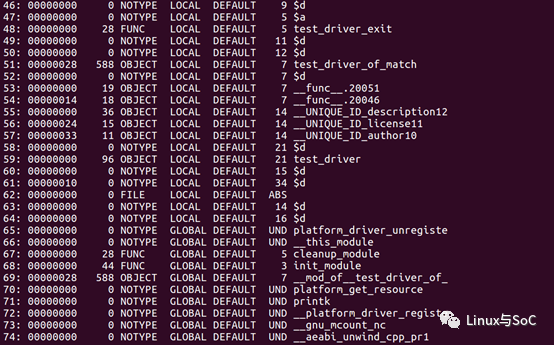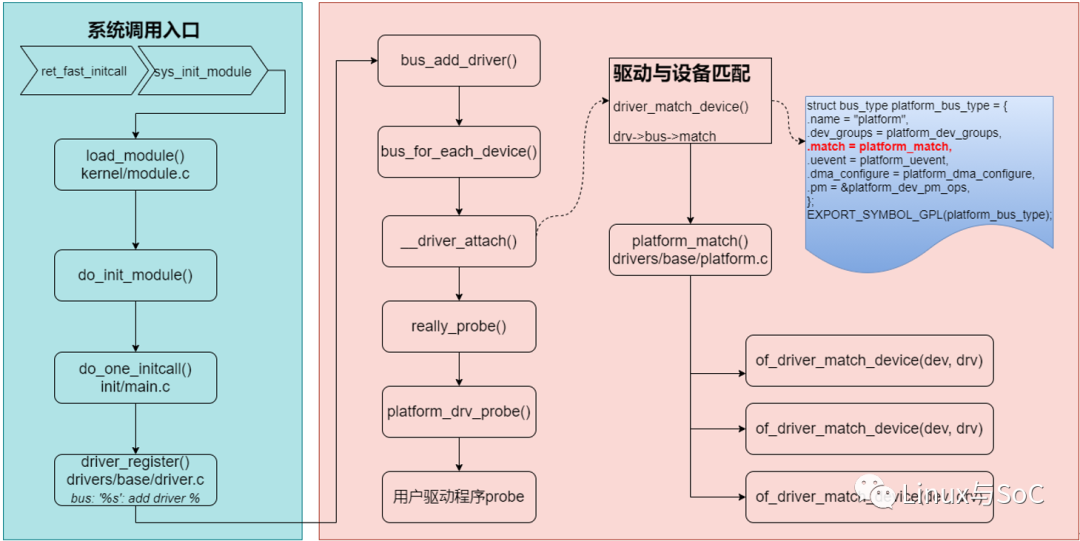介绍
在linux kernel中通过
module_platform_driver来实现模块化平台驱动。大量的设备驱动程序都基于该种方式来实现,使用频次非常的高,在linux kernel 5.4.124的代码中搜索module_platform_driver共有2356次引用。
 这个宏的使用方式大相径庭,有一套成熟的代码书写方式,将驱动程序入口符号作为宏的参数,基本格式如下:
这个宏的使用方式大相径庭,有一套成熟的代码书写方式,将驱动程序入口符号作为宏的参数,基本格式如下:

历史
它的定义在include/linux/platform_device.h中,从文件的名字来看可知它存在的意义是基于platform_device的。platform_device.h这个文件在2005年的linux-2.6.15就存在了。

platform_device.h在创建初期并没有现在这么多丰富的功能,通过platform_xxx_register来注册驱动和设备,并没有提供module_platform_driver这个辅助宏。
/** platform_device.h - generic, centralized driver model** Copyright (c) 2001-2003 Patrick Mochel <mochel@osdl.org>** This file is released under the GPLv2** See Documentation/driver-model/ for more information.*/#ifndef _PLATFORM_DEVICE_H_
#define _PLATFORM_DEVICE_H_#include <linux/device.h>struct platform_device {const char * name;u32 id;struct device dev;u32 num_resources;struct resource * resource;
};#define to_platform_device(x) container_of((x), struct platform_device, dev)extern int platform_device_register(struct platform_device *);
extern void platform_device_unregister(struct platform_device *);extern struct bus_type platform_bus_type;
extern struct device platform_bus;extern struct resource *platform_get_resource(struct platform_device *, unsigned int, unsigned int);
extern int platform_get_irq(struct platform_device *, unsigned int);
extern struct resource *platform_get_resource_byname(struct platform_device *, unsigned int, char *);
extern int platform_get_irq_byname(struct platform_device *, char *);
extern int platform_add_devices(struct platform_device **, int);extern struct platform_device *platform_device_register_simple(char *, unsigned int, struct resource *, unsigned int);extern struct platform_device *platform_device_alloc(const char *name, unsigned int id);
extern int platform_device_add_resources(struct platform_device *pdev, struct resource *res, unsigned int num);
extern int platform_device_add_data(struct platform_device *pdev, void *data, size_t size);
extern int platform_device_add(struct platform_device *pdev);
extern void platform_device_put(struct platform_device *pdev);struct platform_driver {int (*probe)(struct platform_device *);int (*remove)(struct platform_device *);void (*shutdown)(struct platform_device *);int (*suspend)(struct platform_device *, pm_message_t state);int (*resume)(struct platform_device *);struct device_driver driver;
};extern int platform_driver_register(struct platform_driver *);
extern void platform_driver_unregister(struct platform_driver *);#define platform_get_drvdata(_dev) dev_get_drvdata(&(_dev)->dev)
#define platform_set_drvdata(_dev,data) dev_set_drvdata(&(_dev)->dev, (data))#endif /* _PLATFORM_DEVICE_H_ */platform_xxx_register这类宏在linux kernel 5.4.124中也在使用。

不能通过引用计数少或者版本迭代的原因来评价这两类宏谁好谁坏,各自有各自的应用场景。当使用platform_xxx_register时,基本格式也是比较固定的,例如:
static int __init ehci_platform_init(void)
{if (usb_disabled())return -ENODEV;ehci_init_driver(&ehci_platform_hc_driver, &platform_overrides);return platform_driver_register(&ehci_mv_driver);
}
module_init(ehci_platform_init);static void __exit ehci_platform_cleanup(void)
{platform_driver_unregister(&ehci_mv_driver);
}
module_exit(ehci_platform_cleanup);MODULE_DESCRIPTION("Marvell EHCI driver");
MODULE_AUTHOR("Chao Xie <chao.xie@marvell.com>");
MODULE_AUTHOR("Neil Zhang <zhangwm@marvell.com>");
MODULE_ALIAS("mv-ehci");
MODULE_LICENSE("GPL");
MODULE_DEVICE_TABLE(of, ehci_mv_dt_ids);从2012年linux kernel 3.xx开始增加了module_platform_driver这个宏,一直延续至今。从module_platform_driver的定义处可以发现,它是platform_driver_register的一个封装应用。
#define module_platform_driver(__platform_driver) \module_driver(__platform_driver, platform_driver_register, \platform_driver_unregister)存在的意义和原理
正如前面介绍的module_init这个宏,在使用它的时候要定义两个函数以及生命两个宏。而使用了module_platform_driver这个宏之后,只需要一行代码就可以实现这些功能。将module_platform_driver这个宏展开之后,就是module_init这一部分代码内容。
#define module_platform_driver(__platform_driver) \module_driver(__platform_driver, platform_driver_register, \platform_driver_unregister)#define module_driver(__driver, __register, __unregister, ...) \
static int __init __driver##_init(void) \
{ \return __register(&(__driver) , ##__VA_ARGS__); \
} \
module_init(__driver##_init); \
static void __exit __driver##_exit(void) \
{ \__unregister(&(__driver) , ##__VA_ARGS__); \
} \
module_exit(__driver##_exit);驱动的注册与卸载方法采用了platform.c中提供的通用API。
/*** __platform_driver_register - register a driver for platform-level devices* @drv: platform driver structure* @owner: owning module/driver*/
int __platform_driver_register(struct platform_driver *drv,struct module *owner)
{drv->driver.owner = owner;drv->driver.bus = &platform_bus_type;drv->driver.probe = platform_drv_probe;drv->driver.remove = platform_drv_remove;drv->driver.shutdown = platform_drv_shutdown;return driver_register(&drv->driver);
}
EXPORT_SYMBOL_GPL(__platform_driver_register);module_init这个宏在include/linux/module.h中定义,在kernel初始化过程中调用do_initcall()或插入驱动ko文件时得到执行。每个驱动模块仅需实现一个module_init与module_exit即可。驱动代码在使用module_platform_driver注册驱动时,经过编译后的文件内容如下:

module_init宏最终是调用了__initcall(x),定义了程序链接时的初始化等级为1。
#define module_init(x) __initcall(x);
#define __initcall(fn) __define_initcall("1", fn)关于initcall:
#ifdef CONFIG_HAVE_ARCH_PREL32_RELOCATIONS
#define ___define_initcall(fn, id, __sec) \__ADDRESSABLE(fn) \asm(".section \"" #__sec ".init\", \"a\" \n" \"__initcall_" #fn #id ": \n" \".long " #fn " - . \n" \".previous \n");
#else
#define ___define_initcall(fn, id, __sec) \static initcall_t __initcall_##fn##id __used \__attribute__((__section__(#__sec ".init"))) = fn;
#endif而通过module_init定义的驱动API编译后的符号表示都增加了initcall的前缀

最后,透过一张图看清module_platform_driver声明的驱动调用流程:

END
推荐阅读:
专辑|Linux文章汇总
专辑|程序人生
专辑|C语言
我的知识小密圈
关注公众号,后台回复「1024」获取学习资料网盘链接。
欢迎点赞,关注,转发,在看,您的每一次鼓励,我都将铭记于心~

嵌入式Linux
微信扫描二维码,关注我的公众号






转载)




)







